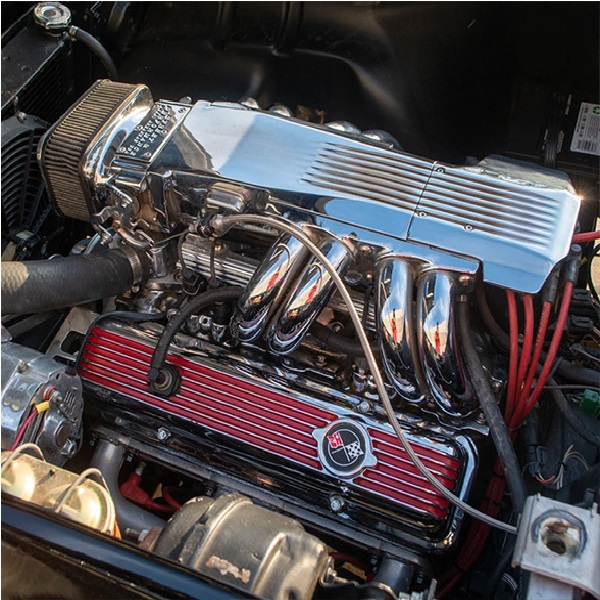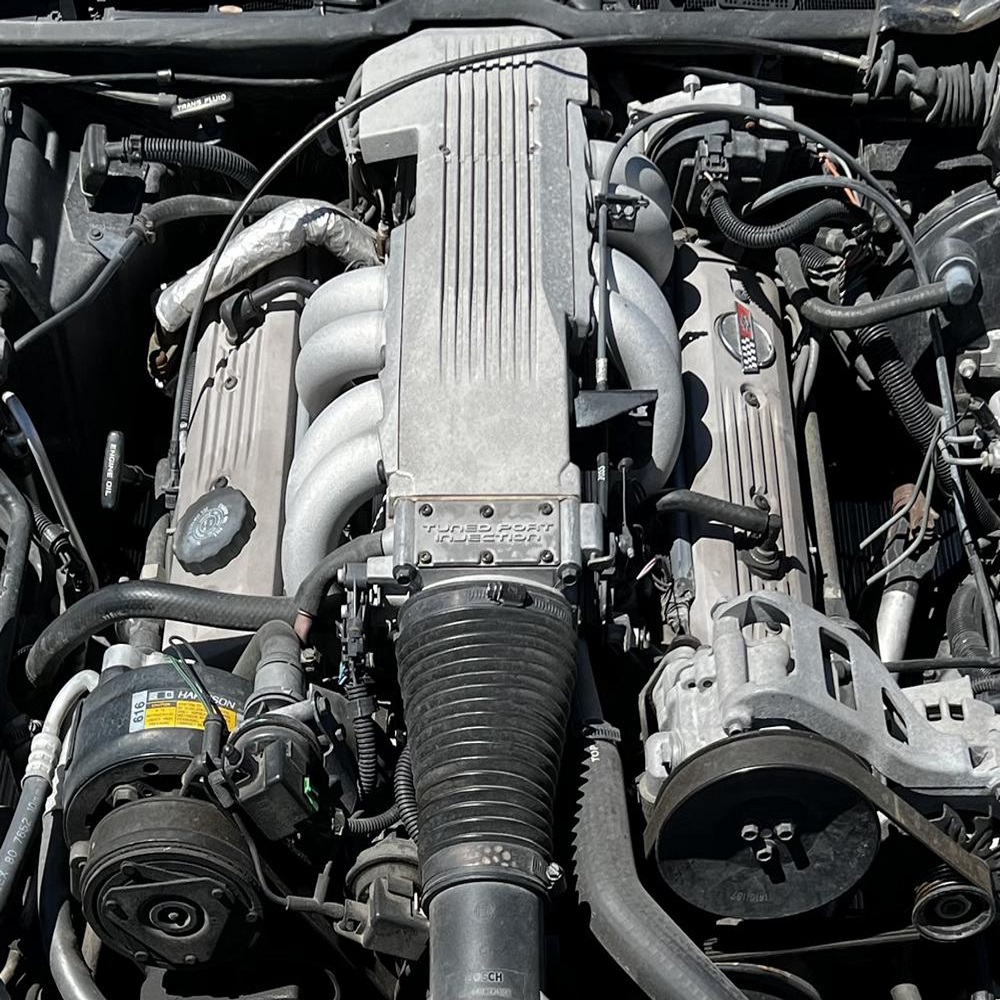The Chevrolet L98 engine has a rich history within the General Motors (GM) family, powering iconic vehicles like the Corvette and Camaro during the 1980s and early 1990s. This L98 engine served as a capable and refined powerplant, leaving a lasting impression on driving enthusiasts. This comprehensive guide delves into the L98 engine’s specifications, performance characteristics, applications, and evolution throughout its production years.
Unveiling the L98 Engine’s Design and Specifications
The L98 engine belonged to GM’s renowned small-block V8 engine family. Introduced in 1985 for the Corvette C4, the L98 was a significant upgrade over its predecessor, the L82 engine. Here’s a closer look at its key features:

-
Displacement: The L98 boasted a 5.7-liter (350 cubic inch) displacement, offering a healthy balance between power and practicality.
-
Configuration: This V8 engine featured a classic 90-degree cylinder bank angle, a design known for its compactness and smooth operation.
-
Block Construction: The engine block was constructed from cast iron, providing a robust foundation for handling the forces generated during combustion.
-
Cylinder Heads: Early iterations of the L98 utilized cast iron cylinder heads, while later models incorporated aluminum cylinder heads for improved weight savings and performance potential.
-
Fuel Delivery: A significant departure from its carburetor-equipped predecessor, the L98 engine came standard with Tuned-Port Fuel Injection (TPI). This electronically controlled fuel injection system offered precise fuel metering, improved performance, and better emissions control.
Horsepower and Performance: The L98 Engine’s Capabilities
The L98 engine’s output varied slightly depending on the model year and specific application. Here’s a general overview of its horsepower range:
-
1985-1986: Early L98 engines produced 230 horsepower and 330 lb-ft of torque.
-
1987-1989: Horsepower increased to 240 horsepower (245 horsepower with a specific rear axle ratio in 1988-1989) with torque figures remaining at 330 lb-ft.

-
1990-1991: Power remained consistent at 245 horsepower, while torque figures stayed the same.
While not the most powerful engine on the market, the L98 offered a satisfying driving experience. Its smooth power delivery, combined with a throaty exhaust note, made it a favorite among performance enthusiasts.
A Legacy of Power: Applications of the L98 Engine
The L98 engine found its home in several iconic GM vehicles throughout its production run:
-
Chevrolet Corvette C4 (1985-1991): The L98 engine served as the standard powerplant for the Corvette C4, propelling this legendary sports car to exhilarating performance.
-
Chevrolet Camaro and Pontiac Firebird (1987-1992): The L98 was available as an optional engine upgrade for these popular muscle cars, offering a significant power boost over the base engines.
These applications solidified the L98’s reputation as a capable and desirable performance engine, leaving a lasting mark on automotive history.
Evolution and Legacy:
The L98 Engine’s Place in History
The L98 engine’s production run ended in 1991, paving the way for more advanced powerplants within the GM lineup. However, its legacy continues to resonate with car enthusiasts. Here’s a look at its impact:
-
A Bridge Between Carburetor and Fuel Injection: The L98 marked a significant transition for GM, introducing fuel injection technology to a wider range of performance vehicles. This shift paved the way for cleaner emissions and improved fuel efficiency without sacrificing power.
-
A Benchmark for Performance: The L98 engine offered a well-balanced combination of power, refinement, and reliability. It established a benchmark for performance in its era, influencing future generations of GM engines.

-
A Collector’s Dream: Vehicles equipped with the L98 engine are now sought-after by collectors, particularly well-maintained Corvettes and Camaros. These cars represent a specific era in automotive history and offer a unique driving experience.
Beyond Nostalgia: Is the L98 Engine Still Relevant Today?
While the L98 engine is no longer in production, its influence is still felt in modern GM powertrains. Advancements in technology have led to even more powerful and efficient engines. However, the L98’s combination of power, reliability, and relative simplicity continues to hold appeal for some enthusiasts. Here’s a breakdown of the L98’s relevance in today’s automotive landscape:
-
Platform for Modifications: The L98 engine serves as a popular platform for modifications among enthusiasts. Its robust design and readily available aftermarket parts allow owners to increase horsepower and performance significantly.
-
Affordability and Maintainability: Compared to modern engines, the L98 is generally more affordable to purchase and maintain. The simpler design makes it easier for experienced mechanics to work on, reducing repair costs.

-
Classic Muscle Car Experience: For enthusiasts seeking a taste of classic muscle car performance, the L98 offers a genuine experience. Its throaty exhaust note and engaging driving dynamics provide a unique connection to automotive history.
However, there are also limitations to consider:
-
Fuel Efficiency: Modern engines boast significantly better fuel economy compared to the L98. This can be a deciding factor for everyday driving, especially with rising fuel costs.
-
Emissions Compliance: Meeting modern emissions standards can be challenging with an unmodified L98 engine. This might be a concern for owners in areas with stricter regulations.
-
Power Output: While modifications can enhance the L98’s performance, it may not compete with the raw power figures of modern high-performance engines.
The Future of L98-Equipped Vehicles:
Preservation and Performance
The future of L98-equipped vehicles likely lies in two distinct areas: preservation and performance enhancement.
-
Preservation: As these cars become more collectible, some owners will choose to meticulously preserve them in their original state. This ensures the historical significance of the engine is not lost.
-
Performance Enhancement: The thriving aftermarket industry surrounding the L98 engine allows enthusiasts to unlock its full potential. Advancements in performance parts and tuning techniques will continue to push the boundaries of the L98’s capabilities.
A Legacy of Power and Performance
The L98 Engine’s Enduring Appeal
The L98 engine may no longer be a powerhouse in the face of modern technology, but its legacy remains strong. Its role in ushering in fuel injection technology, its well-rounded performance characteristics, and its significance in iconic vehicles solidify its place in automotive history. For enthusiasts seeking a classic muscle car experience or a platform for modifications, the L98 engine continues to hold a unique appeal.
Cultural Impact
Beyond the technical and performance aspects, the L98 5.7 OHV 350 V-8 engine has had a significant cultural impact. It symbolizes an era when American automotive engineering found ways to maintain high performance while adapting to new environmental and regulatory challenges. The L98 is often seen as a bridge between the raw, unregulated power of the muscle car era and the more refined, engineered performance of modern engines.
Cars equipped with the L98 are celebrated in car shows, races, and auto enthusiast gatherings. The engine’s reputation for being both powerful and reliable has cemented its place in automotive history. Whether in a restored Corvette or a modified Camaro, the L98 continues to turn heads and capture hearts.

Practical Considerations
While the L98 5.7 OHV 350 V-8 is celebrated for its performance and durability, owning and maintaining one requires some practical considerations. Parts for the L98 are generally accessible, but sourcing high-quality components might require some effort. The aftermarket support for this engine is robust, but it’s essential to choose parts that maintain or enhance the engine’s integrity.
Regular maintenance is crucial to keep an L98 engine running smoothly. Given its age, attention to detail is essential, from ensuring proper oil levels and quality to checking the condition of the fuel injection system and other critical components. For those who are passionate about automotive restoration or performance tuning, the L98 offers a rewarding hands-on experience.
Ownership Stories
Many car enthusiasts have stories about their experiences with the L98 5.7 OHV 350 V-8 engine. These stories often begin with the thrill of their first drive and extend to the countless hours spent tuning and modifying the engine. For some, owning an L98-equipped car is about reliving their youth, while for others, it’s about appreciating a piece of engineering history.
In 2024, forums and social media platforms are filled with discussions about the best ways to maintain, modify, and enjoy cars with the L98 engine. The shared experiences and wealth of knowledge available help new and seasoned owners alike make the most of their vehicles.
The Future of the L98
As technology continues to advance, the legacy of the L98 5.7 OHV 350 V-8 engine is secure, even in a world increasingly focused on electric and hybrid vehicles. The simplicity and robustness of the engine make it a prime candidate for future restorations and modifications. In the coming years, we may see more innovative ways to integrate modern technology into these classic engines, blending the best of both worlds.
Experimental projects might involve integrating hybrid systems or exploring alternative fuels, ensuring that the L98 remains both a nostalgic and functional piece of machinery. Car enthusiasts are always looking for ways to push the boundaries, and the L98 provides a versatile platform for creative engineering.
Unleash Your Inner Gearhead:
Explore Performance Parts for Your L98 Engine
Are you the proud owner of a car equipped with the legendary L98 engine? Looking to unlock its full potential and experience the thrill of classic muscle car performance? Look no further! Our extensive catalog features a wide range of performance parts specifically designed for the engine. The L98 5.7 OHV 350 V-8 engine, a stalwart of automotive engineering, has a rich history that continues to influence modern engine designs even in 2024. From performance air intake systems and exhaust upgrades to camshafts and engine management solutions, we have everything you need to take your L98 to the next level. Visit our website today and explore the possibilities!


